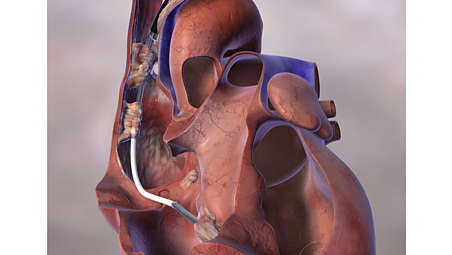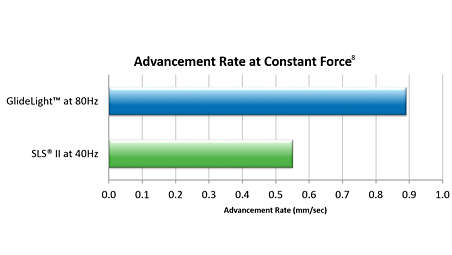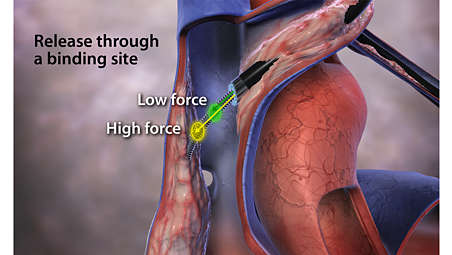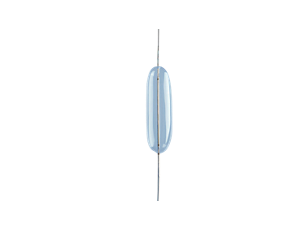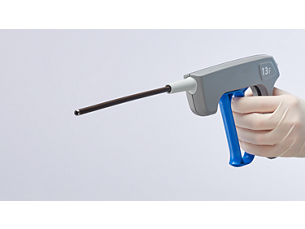Specifications
- GlideLight model number 500-301
-
GlideLight model number 500-301 Sheath size - 12 F
Maximum target lead diameter - 7.5 F / 0.098" / 2.50 mm
Minimum tip inner diameter - 8.3 F / 0.109" / 2.77 mm
Maximum tip outer diameter - 12.5 F / 0.164" / 4.17 mm
Working length - 50 cm
Repetition rate - 25-80 Hz
Clinical energy setting - 30-60 mJ/mm
-
- GlideLight model number 500-302
-
GlideLight model number 500-302 Sheath size - 14 F
Maximum target lead diameter - 9.5 F / 0.124"/ 3.17 mm
Minimum tip inner diameter - 10.2 F /0.134" / 3.40 mm
Maximum tip outer diameter - 14.7 F / 0.192" / 4.88 mm
Working length - 50 cm
Repetition rate - 25-80 Hz
Clinical energy setting - 30-60 mJ/mm
-
- GlideLight model number 500-303
-
GlideLight model number 500-303 Sheath size - 16 F
Maximum target lead diameter - 11.5 F / 0.150" / 3.83 mm
Minimum tip inner diameter - 12.5 F / 0.164" / 4.17 mm
Maximum tip outer diameter - 17.2 F / 0.225" / 5.72 mm
Working length - 50 cm
Repetition rate - 25-80 Hz
Clinical energy setting - 30-60 mJ/mm
-
- SLS II model number 500-001
-
SLS II model number 500-001 Max. target lead diameter - 7.5 F / 0.098" / 2.50 mm
Min. inner tip diameter - 8.3 F / 0.109" / 2.77 mm
Max. outer tip diameter - 12.5 F / 0.164" / 4.17 mm
Working length - 50 cm
Repetition rate - 20-40 Hz
Clinical energy setting - 30-60 mJ/mm
-
- GlideLight model number 500-301
-
GlideLight model number 500-301 Sheath size - 12 F
Maximum target lead diameter - 7.5 F / 0.098" / 2.50 mm
-
- GlideLight model number 500-302
-
GlideLight model number 500-302 Sheath size - 14 F
Maximum target lead diameter - 9.5 F / 0.124"/ 3.17 mm
-
- GlideLight model number 500-301
-
GlideLight model number 500-301 Sheath size - 12 F
Maximum target lead diameter - 7.5 F / 0.098" / 2.50 mm
Minimum tip inner diameter - 8.3 F / 0.109" / 2.77 mm
Maximum tip outer diameter - 12.5 F / 0.164" / 4.17 mm
Working length - 50 cm
Repetition rate - 25-80 Hz
Clinical energy setting - 30-60 mJ/mm
-
- GlideLight model number 500-302
-
GlideLight model number 500-302 Sheath size - 14 F
Maximum target lead diameter - 9.5 F / 0.124"/ 3.17 mm
Minimum tip inner diameter - 10.2 F /0.134" / 3.40 mm
Maximum tip outer diameter - 14.7 F / 0.192" / 4.88 mm
Working length - 50 cm
Repetition rate - 25-80 Hz
Clinical energy setting - 30-60 mJ/mm
-
- GlideLight model number 500-303
-
GlideLight model number 500-303 Sheath size - 16 F
Maximum target lead diameter - 11.5 F / 0.150" / 3.83 mm
Minimum tip inner diameter - 12.5 F / 0.164" / 4.17 mm
Maximum tip outer diameter - 17.2 F / 0.225" / 5.72 mm
Working length - 50 cm
Repetition rate - 25-80 Hz
Clinical energy setting - 30-60 mJ/mm
-
- SLS II model number 500-001
-
SLS II model number 500-001 Max. target lead diameter - 7.5 F / 0.098" / 2.50 mm
Min. inner tip diameter - 8.3 F / 0.109" / 2.77 mm
Max. outer tip diameter - 12.5 F / 0.164" / 4.17 mm
Working length - 50 cm
Repetition rate - 20-40 Hz
Clinical energy setting - 30-60 mJ/mm
-
- 1. Comparison of average peak push forces required to advance Laser Sheath at 40Hz vs. 80Hz Pulse Repetition Rate through simulated fibrosis material at an advancement rate of 1.0 mm/second. D015722, Data on file at Philips
- 2. Comparison of ablation force vs. advancement rate of Laser sheath 40Hz vs. 80Hz by use of the data collected in D015786, Data on file at Philips
- 3. Maytin M, Epstein, L (2011). The challenges of transvenous lead extraction. Heart, 97(5): 425-34.
- 4. Henrikson, C.A., et al. (2008). How to prevent, recognize, and manage complications of lead extraction. Part III: Procedural factors Heart Rhythm. Jul;5(7):1083-7. Epub 2007 Oct 9.
- 5. Smith MC, Love CJ. Extraction of transvenous pacing and ICD leads. Pacing Clin Electrophysiol 2008:31:736-52.
- 6. Wilkoff, B.L., et al. (1999). Pacemaker lead extraction with the laser sheath: Results of the Pacing Lead Extraction with Excimer Sheath (PLEXES) trial. JACC, 33(6), 1671-1676.
- 7. Reduced advancement force lowers the forces applied to leads during extraction, D015861-01, Data on file at Philips
- 8. Design Verification Report for Ablation Force Testing. D015722, Data on file at Philips.
- Product availability is subject to country regulatory clearance. Please contact your local sales representative to check the availability in your country.
- GlideLight is distributed by LifeSystems in Australia and New Zealand.
- Always read the label and follow the directions for use.
- Philips medical devices should only be used by physicians and teams trained in interventional techniques, including training in the use of this device.
- Philips reserves the right to change product specifications without prior notification.
- ©2025 Koniklijke Philips N.V. All rights reserved. Trademarks are the property of Koninklijke Philips N.V. or their respective owners.
- Laser Sheath GlideLight Important safety information GlideLight Laser Sheath is intended for use with other lead extraction tools in patients who are suitable candidates for removal of implanted pacemaker and defibrillator leads. The use of GlideLight Laser Sheath may be unsafe in some patients, or with certain leads, or when the leads cannot be extracted through the superior veins (that is, when groin or surgical extraction is required). Rarely a patient undergoing lead extraction may require urgent surgical treatment for a complication; therefore, patients should not undergo lead extraction with a laser sheath in centers where emergency surgical procedures cannot be performed. Leads not intended for extraction may be damaged during the procedure and may require replacement. Ask your doctor if you are a candidate for lead extraction with GlideLight Laser Sheath.
- Potential minor adverse events associated with lead extraction procedures that may or may not require medical or surgical treatment include: a tear or damage to the blood vessels, the heart or its structures; bleeding at the surgical site; or collapsed lung. Rare but serious adverse events that require emergency medical or surgical procedures may include: a tear or damage to the blood vessels, the heart, lungs or their structures; blood clot or obstruction of the blood vessels or lungs by debris or lead fragments. Other serious complications may include: irregular heartbeat, weakened heart muscle, infection, respiratory failure or complications associated with anesthesia, stroke or death. This information is not intended to replace a discussion with your healthcare provider on the benefits and risks of this procedure to you. Caution: Federal law restricts this device to sale by or on the order of a physician.
